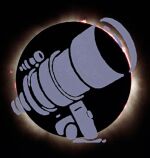 Meade 16"
LX200GPS UHTC telescope
Meade 16"
LX200GPS UHTC telescope 

 Meade 16"
LX200GPS UHTC telescope
Meade 16"
LX200GPS UHTC telescope 

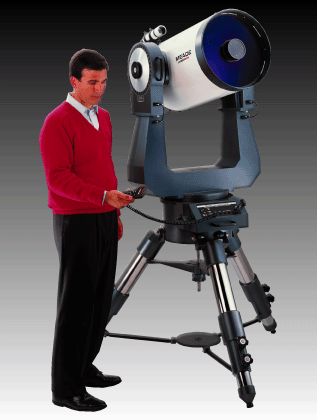 Meade 16" LX200GPS Schmidt-Cassegrain telescope, with Super giant Field Tripod. |
Professional
instrumentation for the demanding school, college, or university research
program—or as the ultimate personal telescope for the advanced amateur With features generally offered only on custom-manufactured professional instruments, this largest of all Meade Schmidt-Cassegrains (in fact, the largest production Schmidt-Cassegrain in the world) fulfills the most demanding state-of-the-art requirements for the school, college, or university teaching or research program, or for the advanced amateur. Professional-grade optical system: Continuing the tradition of Meade 8", 10", and 12" SCT optics, the 16" LX200GPS yields the superlative imaging required in advanced applications, whether in planetary or deep-space visual or CCD imaging in astrophotography, or in photometry. And, with its super clear BK7 optical glass correcting plate, the 16" LX200GPS may be used into the ultraviolet spectral region as well. Adding the Meade Ultra-High Transmission Coatings group increases the telescope's effective image-brightness and resolution aperture over the visible spectrum to 17.3" Oversize one-piece fork mounting: The massive 16" LX200GPS fork system, cast in one continuous piece from one Declination housing to the other, includes a total of four 80mm roller bearings in Declination (two in each Declination housing) and two roller bearings in Right Ascension (one each 100mm and 150mm bearings in the RA housing). Such liberal usage of precision roller bearings into the telescope's design permits the addition of substantial auxiliary equipment without risk of strain on the mechanism and results in the most rigid tracking platform available on a production telescope. Large DC-servo-motor-driven 11" worm gears on both telescope axes yield the smooth, precision tracking and slewing required of a professional instrument. |
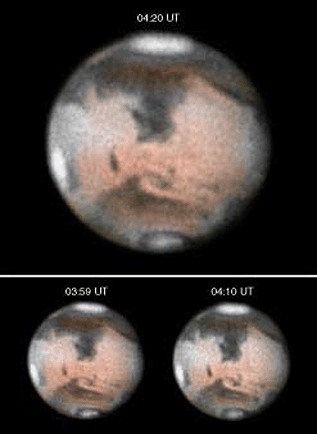 The planet Mars, March 29, 1997, imaged by Dr. Donald Parker using a Meade 16" LX200 telescope and Pictor 416XT imager. In these images south is up. The north polar cap is visible below the Utopia region with Syrtis Major, perhaps the most prominent Martian surface feature, just south of the equator. The large white area near Mars' south pole is the Hellas asteroid impact basin. Dr. Parker writes, "The Meade 16" LX200 delivers extraordinary images and is a pleasure to use. It is rare for a commercial telescope of this aperture to show stellar images with such well-defined Airy discs and diffraction rings. The optical requirements for my imaging work are extremely high, and the 16" LX200 has fully met these requirements." |
Autostar
II technology: The purchaser of a Meade 16" LX200 is acquiring
some of the most advanced technology ever built into a commercial
telescope. Technology that includes all of the following features:
Automatic GO TO capability to any of 145,000 objects in the onboard database, or to any RA and Dec. input to the Autostar II keypad, and with a pointing precision of better than 2 arc minutes in either the altazimuth or equatorial mode. A High-Precision Pointing mode capable of pointing the telescope, automatically, to a precision of better than one arc-minute, if required. 165 drive speeds on both axes, pushbutton-actuated from the Autostar II controller: 0.01x to 1.0x sidereal, variable in 0.01x increments; 2x, 8x, 16x, 64x, 128x sidereal; 1°/sec. to6°/sec., variable in 0.1° increments. Microprocessor-controlled sidereal-rate tracking (or one of 2000 other incrementally-variable solar, lunar, or planetary-rates) in either the altazimuth or equatorial modes, with tracking periodic error at an observatory-standard 5 arc seconds or less using the factory-programmed Smart Drive in both RA and Dec. |
|
|
|
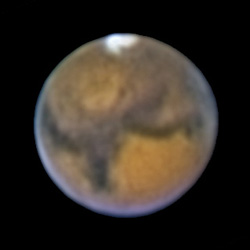
Mars on the night of Septembert 6/7; south is up. Syrtis Major is the dark triangle to the lower-left of center with the light-colored basin Hellas visible above it. Dark Sinus Sabaeus stretches off to the right, extending into Sinus Meridiani. Senior Sky & Telescope Dennis di Cicco shot a minute of video with a Philips ToUcam Pro video camera attached to his 16-inch Meade LX200 at f/28. After processing with Registax, 105 of the best frames were stacked to produce this view. Image by Dennis di Cicco, final processing by Sean Walker. |
|
| The
Meade 4-speed
Zero Image-Shift Microfocuser
for precise focusing in sensitive lunar, planetary, or deep-space
observing and simultaneously to maintain precise image centration in CCD
imaging applications.
Modern control-panel design, with connectors for a wide range of optional accessories and features, including CCD autoguider, illuminated reticle eyepiece, field de-rotater, and optical tube thermal stabilization fan, as well as an RS-232 serial port connector. Supergiant Field Tripod and Permanent Piers: The 16" LX200GPS is offered with a choice of tripod or piers, each suitable to specific user applications: Supergiant Field Tripod: Supplied with the Supergiant Field Tripod, the 16" LX200GPS is remarkably field-transportable for an instrument of its aperture and specifications. The telescope is manufactured in four basic modules (optical tube assembly with Declination housings attached; fork arm system; drive base; and field tripod) and, as such, is readily transported and set-up in the field by two adults in about 10 minutes. The extremely strong and rigid tripod assembly, incorporating 4"-diameter steel tripod legs, results in virtually no compromise whatever in telescope stability, as compared to the permanent pier systems described below. Placed atop the Supergiant Field Tripod, the 16" LX200GPS operates in the altazimuth mode with the tracking and pointing accuracies previously described. For visual observing, or for CCD imaging or astrophotography not exceeding four to five minutes' duration, no additional equipment is required. During longer periods of imaging or photography, however, field rotation, an effect inherent to any altazimuth-mounted telescope, becomes apparent. The result of such field rotation during photography or imaging is to cause stars at the outer edge of the field to appear to rotate relative to the centrally-located star, even if the exposure is perfectly guided. This effect can be cancelled completely and precisely by adding the optional Meade #1222 Field De-rotater (below). Permanent Altazimuth Pier: For observatory applications the 16" LX200GPS may be ordered with the Permanent Altazimuth Pier, a mounting system that results in comfortable, readily-accessible eyepiece positions at all telescope pointing locations and is ideal in those environments where the instrument must be housed in a minimum of space. |
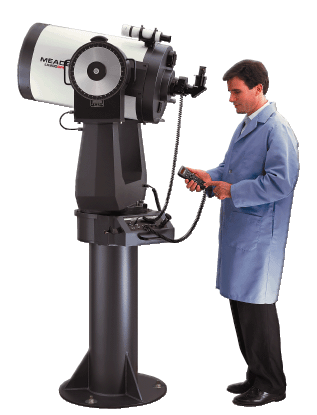 |
| Home Pulse Acquisition: Included as standard equipment with all 16" LX200GPS models, and unique among commercial telescopes, is a special "home pulse" feature that allows the telescope's operating system to maintain the telescope's pointing position in non-volatile memory, even when the telescope is turned off. The advantage of such a system is that the telescope may be remotely aligned and operated over an arbitrarily long distance, through a modem link to the telescope's RS-232 serial interface. In this way Meade 16" LX200GPS telescopes may be operated through a pre-programmed sequence of, for example, CCD imaging, without a human operator being present in the observatory.ry. | |
| Using
the Meade 16" LX200GPS: Meade 16" Schmidt-Cassegrain
telescopes have been shipped worldwide to advanced amateurs, schools, and
university observatories, where they are regularly used in programs of
serious astronomical research — research that ranges from remote imaging
and photometry of variable stars to supernova patrols, asteroid
cataloging, and planetary studies. Shown on this page are images that
attest to the remarkable level of planetary and deep-space resolution
obtainable with the 16" LX200GPS. Specifications: 16" Model LX200GPS—Includes 16" Schmidt-Cassegrain optical tube assembly (D = 406mm, F = 4064mm, f/10) with MgF2 coatings on the correcting lens and standard aluminum coatings on the primary and secondary mirrors (Ultra-High Transmission Coatings, available optionally); primary mirror lock; 4-speed Zero Image-Shift Microfocuser; heavy-duty, one-piece fork mount with 6 roller bearings and dual-axis 11" worm gears; 7-port multi-function control panel, including RS-232 serial interface and field de-rotater ports; manual and electric slow-motion controls on both axes; thermal stabilization fan; setting circles in RA and Dec; Autostar II control system with 3.5-Megabyte flash memory, digital readout display, factory-programmed Smart Drive and 165-speed drive controls on both axes, High-Precision Pointing, and 145,000-object onboard celestial software library; GPS alignment system with 16-channel GPS receiver, magnetic declination compensation, and true-level and North electronic sensors; home-pulse software for remote telescope operation; 25 ft. power cord and adapter for telescope operation from 115v AC (for field operation from 12v DC auto cigarette lighter plug, see optional #1812A Electronic DC Adapter); 8x50mm viewfinder; 2" diagonal mirror with 1.25" adapter; Series 4000 Super Plössl 26mm eyepiece (156x); operating instructions; shipped in foam-fitted export-quality cartons. Choice of tripod or piers available at slightly varying prices: supergiant transportable field tripod; permanent altazimuth pier; or permanent equatorial pier. In case of permanent equatorial pier, specify observatory latitude within 0.5°. |
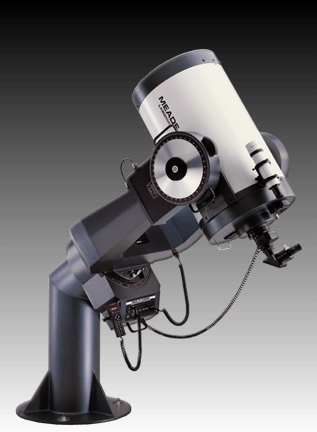 Permanent Equatorial Pier: If auxiliary astro cameras or other long-exposure imaging devices are to be piggybacked to the telescope, then the telescope should be specified with the Permanent Equatorial Pier. Thus mounted in the equatorial mode, there is no field rotation in either the main telescope or in any auxiliary, piggybacked instruments. All Permanent Equatorial Piers are custom-manufactured to match the latitude of the specified observing site. |
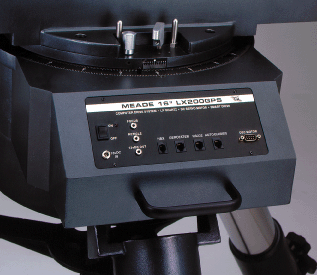 |
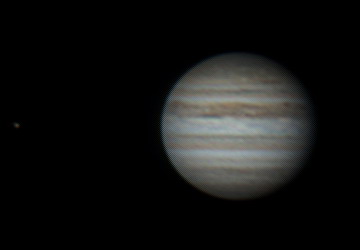 Jupiter & Io taken with 16" LX200 DBK21AF04AS 1150 frames 25-10-09 courtesy Daniel Chang |
|
美德(Meade)16"LX200GPS天文望遠鏡規格镜 光學系統:施密特-卡塞格林;有效口径:406.4mm;全鏡直径:415.9mm 焦距4064mm;焦比:f/10;分解能0.28";極限目視星等:15.5; 極限攝影星等 18.0;最大有效放大倍数:800倍配系列高级 镜 鍍膜:超超高透光率鍍膜 (UHTC);主鏡鎖定;4速零漂移微聚焦器;承重叉臂、每個支撑臂安裝6個滚珠軸承;雙軸11"蝸輪轉動器;7個接口多功能控制面板、包括2个RS-232接口和視場旋轉口; 雙軸手動和電動控制低速馬達;熱平衡風扇;赤經和赤緯刻度盤;Autostar II 控制系統帶3.5M閃存、讀數據屏幕、固化可編程智能可驅動和双軸185速驅動控制、高精度瞄準、145,000个天体目標数據庫;GPS對齊系統16頻道GPS接收器、磁偏補償、正北電子存感器;220V交流電源變壓器(可選#1812A 7.62米電繼引出汽車點烟器12V直流供電)為望遠鏡全系統提供12V直流電源;8 x 50mm導星鏡; 2" 對角反光鏡;1.25"目鏡接口;4000系列超級 Plössl 26mm 目鏡(156x);高度可調野外巨型三脚架;操作手册。 |

